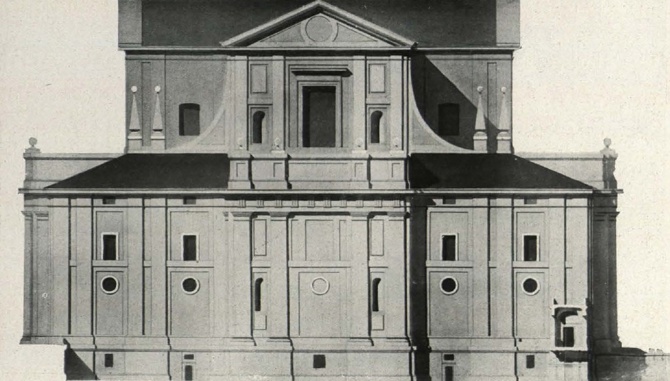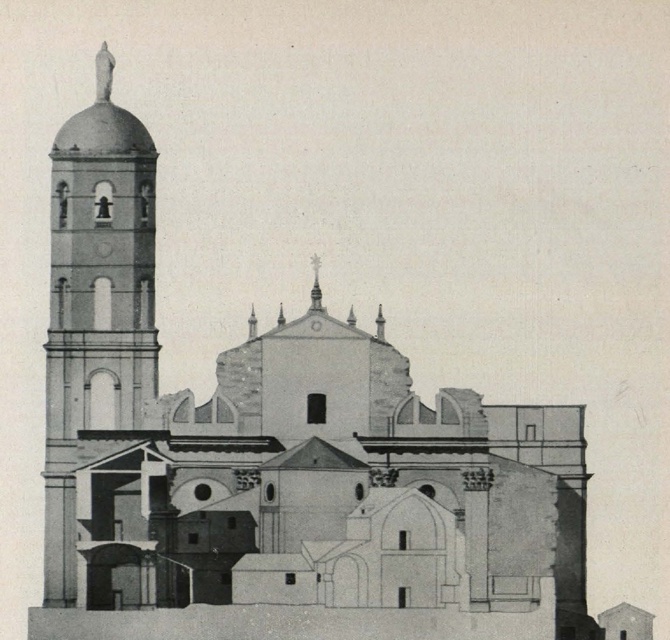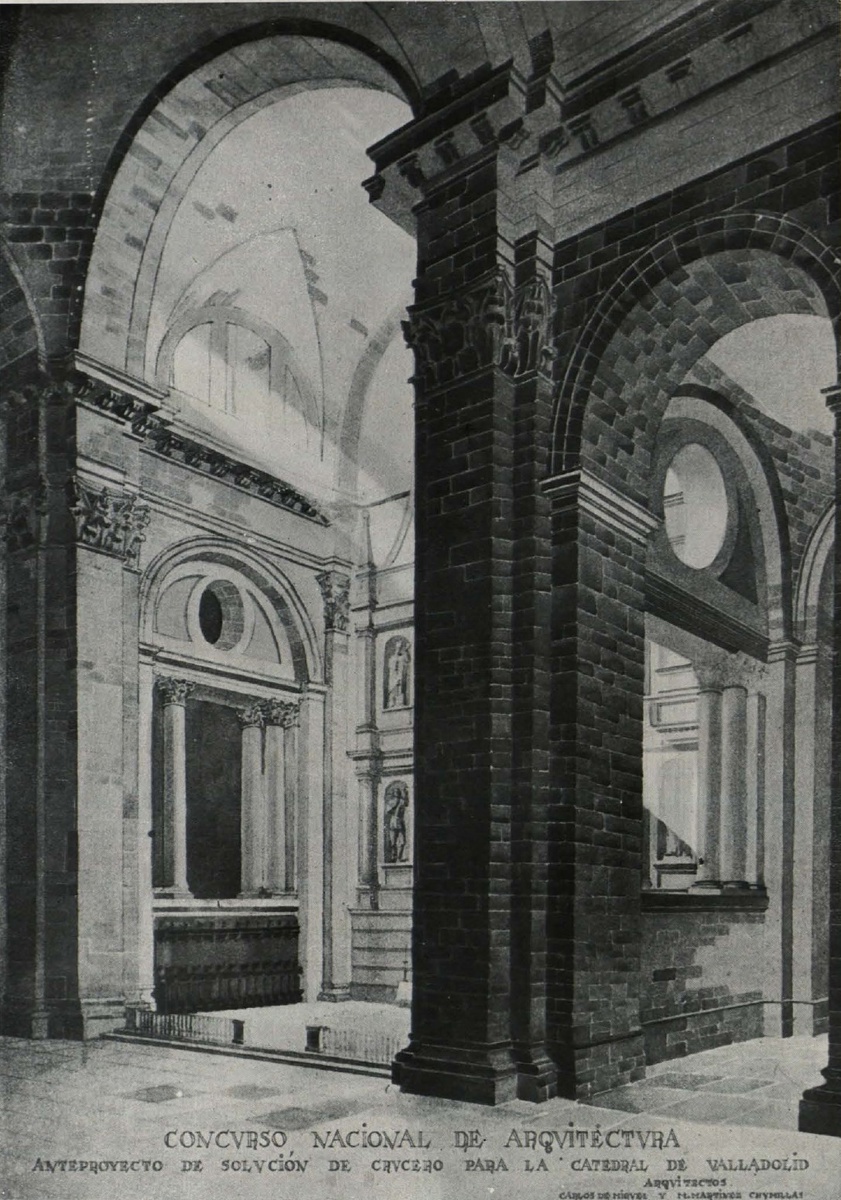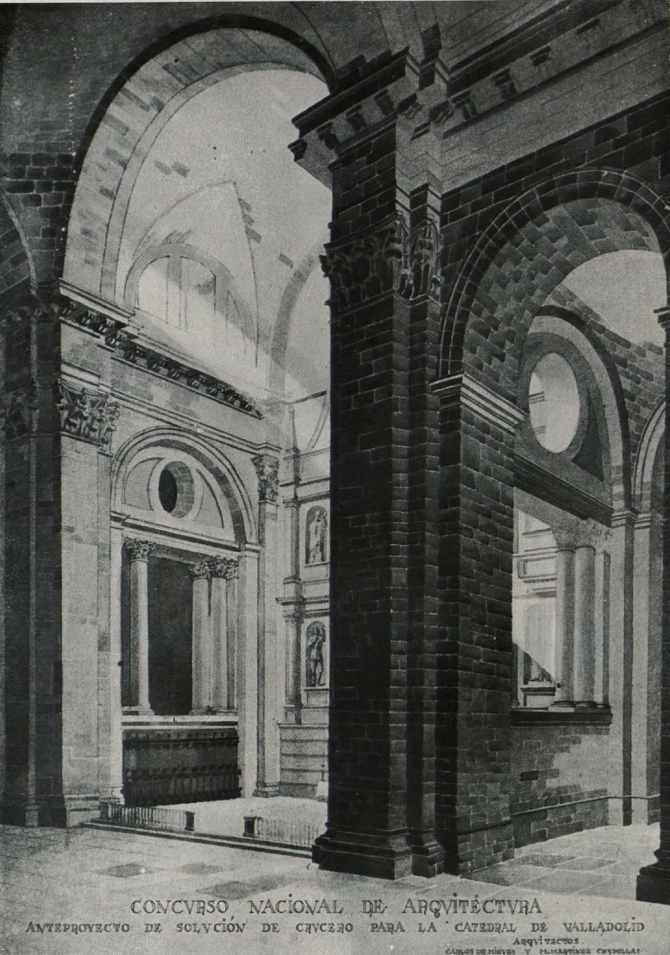Loading...
The project

We are not going to give a detailed description of the project; it is accompanied by the Report, in a more appropriate place than these pages of the journal. We would like to point out that the synthesis of the layout we have adopted has been to resolve the cathedral with all the respect that Herrera deserves, but with our own personal criteria; we have not been invited to extend the façade of the Banco de España, nor to interpret the plans left to us by Diego de Praves. We have kept its style, but we have changed the forms to adapt them to a problem totally different from the one posed by its author. And this has never been a mistake in architecture, where elements are judged by their forms and dimensions. We, at least, do not reject this adaptation according to the true procedures of the style of an era.
Aesthetic concept
The aesthetic problems raised are treated with analogous effects in El Escorial, and the recesses of its gables have been tried and tested, and we have not tried to camouflage them in the drawings of the façades, so we have included a perspective made with scientific rigour of this rear part from the point of view of the observer in the street in our work. Its effect can be seen in the overall side façade, which is the typical silhouette of a Spanish cathedral, symmetrical, with an ambulatory, as a solution with the central nave up to this end would produce a cut-off side elevation, with its off-centred door gable, in a totally erroneous solution.

The shortening of the main chapel arm could not allow the disproportion of the side arms according to the overall project. Documentary proof is the photograph of our overall plan, where the masses are studied with the shadows cast. The triple semicircular window has been imposed in the Herrerian manner, piercing the upper part of the walls of the central nave, and the buttresses return to their reasonable line as proposed by the great architect.
Another criterion offered is to emphasise the entablature by emphasising the verticality of the Corinthian pilaster and its connection with the transverse arch. This is an opinion backed up by the attached graphic document; if anyone feels that the plain entablature has a better effect, they can say so; we say, as the well-documented professor Mr. Lafuente Ferrari has just said with regard to this competition, that the aesthetic criterion, in this case, of the solution in such consecrated forms, should not be a preserve of the judgements and opinions of others.
The details adopted are of the utmost architectural concern and are all within the general lines of the style proposed by the author, but the composition of the different elements is based on a general concern for the whole and rejects any other criterion that does not respond to a solution for the finishing touches that has been studied in its entirety. The preliminary design may be as provisional as you like; but if it is realised, which is enough to dream of after half a century, while the transept and its main chapel are being built, it will always present a definitive silhouette.
Functional concept
The functional problem required solving two essential parts: the capacity of the cathedral's services and not depriving this temple of that very Spanish ambulatory in which the classic ambulatory of medieval times has crystallised. The first has been amply resolved without having to resort to the solution of attaching annexes, as has been so justifiably sought in other solutions in this competition. It is well known that Herrera's project, and even the prototype of the Spanish medieval cathedral, did not try to solve this functional problem; the reality is offered by the example of the cathedral of Toledo, with an accumulation of minor and improper adjoining buildings, which overwhelm the clean silhouette of its exterior layout; but the reality is that these services are increasingly necessary. That is why we have had to provide, in addition to the premises on the first floor above the porticoes, a large basement floor which, in addition to offering it to the terrain, is obvious to discuss the greater richness that it provides to our rear façade.
The second part justifying the ambulatory is amply manifested in all our cathedrals, which dare not pass in front of the high altar and allow the procession inside and around the church; most of them have the stations of the Passion of Our Lord for the Lenten exercise of the Stations of the Cross. And nothing more, as justification for our contribution to the competition for the solution of the transept for the cathedral of Valladolid. A project which, like all of them, is subject to criticism, with a modest but personal criterion, always adapted to the purposes of reality, without leaving our ambitious aspiration for those buildings with which our architect ancestors glorified themselves mute.
General information
Solution for the transept of the cathedral of Valladolid and urbanisation of the surrounding area
YEAR
Option to visit
Address
St. Arribas, 1
47002 Valladolid - Valladolid
Latitude: 41.652570511
Longitude: -4.723238197
Classification
Built area
Awards
Information provided by
MITMA
Location
https://serviciosdevcarq.gnoss.com/https://serviciosdevcarq.gnoss.com//imagenes/Documentos/imgsem/05/05f7/05f773e0-5753-4973-b556-778b81ba3f7e/9d2d8a1e-552b-4734-a0f2-bfab3731bd07.jpg, 0000035564/revista-nacional-arquitectura-1943-0001.jpg
https://serviciosdevcarq.gnoss.com//imagenes/Documentos/imgsem/05/05f7/05f773e0-5753-4973-b556-778b81ba3f7e/8c5cf7af-4c75-483b-a980-0fc62b9ba372.jpg, 0000035564/revista-nacional-arquitectura-1943-0006.jpg
https://serviciosdevcarq.gnoss.com//imagenes/Documentos/imgsem/05/05f7/05f773e0-5753-4973-b556-778b81ba3f7e/e7c0c6d0-e445-4684-b1dc-4f3584fc9804.jpg, 0000035564/revista-nacional-arquitectura-1943-0003.jpg
https://serviciosdevcarq.gnoss.com//imagenes/Documentos/imgsem/05/05f7/05f773e0-5753-4973-b556-778b81ba3f7e/596105c0-7a75-4045-bfa2-be90a3eb3697.jpg, 0000035564/revista-nacional-arquitectura-1943-0004.1.jpg
https://serviciosdevcarq.gnoss.com//imagenes/Documentos/imgsem/05/05f7/05f773e0-5753-4973-b556-778b81ba3f7e/7eee5dc1-094a-468e-897c-cee1feb0a65c.jpg, 0000035564/revista-nacional-arquitectura-1943-0004.jpg
https://serviciosdevcarq.gnoss.com//imagenes/Documentos/imgsem/05/05f7/05f773e0-5753-4973-b556-778b81ba3f7e/80e32f1a-511b-4e44-9578-fbff4368ffa9.jpg, 0000035564/revista-nacional-arquitectura-1943-0005.jpg
https://serviciosdevcarq.gnoss.com//imagenes/Documentos/imgsem/05/05f7/05f773e0-5753-4973-b556-778b81ba3f7e/8d46dbc2-312e-4fa8-b6d3-06e40e69baa2.jpg, 0000035564/revista-nacional-arquitectura-1943-0005 planta.jpg
https://serviciosdevcarq.gnoss.com//imagenes/Documentos/imgsem/05/05f7/05f773e0-5753-4973-b556-778b81ba3f7e/3a4515f8-a77a-48c6-bc25-2becfdf3b5dc.jpg, 0000035564/revista-nacional-arquitectura-1943-0006 c.jpg
https://serviciosdevcarq.gnoss.com//imagenes/Documentos/imgsem/05/05f7/05f773e0-5753-4973-b556-778b81ba3f7e/bd766d94-5c4d-463d-8cb6-3fab325b4812.jpg, 0000035564/revista-nacional-arquitectura-1943-0007.jpg
https://serviciosdevcarq.gnoss.com//imagenes/Documentos/imgsem/05/05f7/05f773e0-5753-4973-b556-778b81ba3f7e/3babfb76-e16a-427f-bcdb-d92f7e4445f3.jpg, 0000035564/revista-nacional-arquitectura-1943-0008 s.jpg
https://serviciosdevcarq.gnoss.com//imagenes/Documentos/imgsem/05/05f7/05f773e0-5753-4973-b556-778b81ba3f7e/88841317-dd5f-4d52-9dcb-1b7913055ee6.jpg, 0000035564/revista-nacional-arquitectura-1943-0008.jpg
https://serviciosdevcarq.gnoss.com//imagenes/Documentos/imgsem/05/05f7/05f773e0-5753-4973-b556-778b81ba3f7e/88993d52-4204-4cdb-9290-4ab43516781d.jpg, 0000035564/revista-nacional-arquitectura-1943-0009.jpg
https://serviciosdevcarq.gnoss.com//imagenes/Documentos/imgsem/05/05f7/05f773e0-5753-4973-b556-778b81ba3f7e/21c9b692-3338-4183-ba54-366eacaf8f15.jpg, 0000035564/revista-nacional-arquitectura-1943-0010.jpg
https://serviciosdevcarq.gnoss.com//imagenes/Documentos/imgsem/05/05f7/05f773e0-5753-4973-b556-778b81ba3f7e/2922a363-d455-406f-9526-0374dba79817.jpg, 0000035564/revista-nacional-arquitectura-1943-0011.jpg








